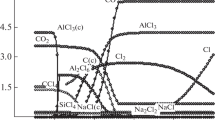Conclusions
-
1.
The chemisorption of ammonia on aluminosilicate catalysts was studied to determine the number of active centers participating in the catalytic process. The amount of chemisorbed ammonia decreases with increasing temperature according to an empirical equation.
-
2.
On samples poisoned with sodium, ammonia is chemisorbed at low temperatures not only on the acid centers, but also on the cationic centers. To determine the acid centers only high-temperature chemisorption should be used.
-
3.
The method of determining acid centers according to the chemisorption of ammonia is free of subjective errors, which are unavoidable in the determination of the transition of the nonionized state of the indicator to the ionized state. Another advantage of the method is the fact that the determination is conducted under conditions closer to those under which the catalyst exists during the chemical reaction (high temperatures, gas phase).
-
4.
The use of the chemisorption of ammonia to determine the number of centers leads to the same results as other methods, namely, to a linear dependence of the catalytic activity on the number of acid centers and to constancy of the activities of the individual centers, regardless of the method of their preparation and the total surface of the sample.
Similar content being viewed by others
Literature cited
H. A. Benesi, J. Phys. Chem.,61, 970 (1957).
V. A. Dzis'ko and S. M. Borisova, Kinetika i Kataliz,1, 144 (1960).
M. W. Tamale, Disc. Faraday Soc.,21, 5490 (1956).
R. L. Richardson and S. W. Benson, J. Phys. Chem.,61, 405 (1957).
F. Braggio and G. Farne, Chimica e Industria,50, 1106 (1968).
D. Beruto, G. Farne, and G. Ferraiolo, Chimica e Industria,51, 59 (1969).
A. Albert and E. Sergeant, Ionization Constants of Acids and Bases [Russian translation], Khimiya (1964).
P. E. Eberly, J. Phys. Chem.,65, 1261 (1961).
K. Pohl and G. Rebentisch, Chem. Technik, No. 8, 496 (1966).
J. Hille, Chem. Technik,8, 466 (1966).
N. E. Buyanova, G. B. Gudkova, and A. P. Karnaukhov, in: Methods of Investigation of Catalysts and Catalytic Reactions [in Russian], Vol. 2, Novosibirsk (1965), p. 55.
V. S. Levchuk and V. A. Dzis'ko, Kinetika i Kataliz,10, 124 (1969).
V. A. Dzis'ko, M. S. Borisova, and N. V. Akimova, Kinetika i Kataliz,5, 689 (1964).
V. S. Levchuk and V. A. Dzis'ko, Kinetika i Kataliz,10, 1289 (1969).
A. Clark and J. Finch, Fundamentals of the Prediction of Catalytic Action. Transactions of the Fourth International Congress on Catalysis [Russian translation], Vol. 11, Izd. Nauka, Moscow (1970), p. 331.
K. T. Geodakyan, A. V. Kiselev, and V. I. Lygin, Zh. Fiz. Khim.,43, 201 (1969).
Author information
Authors and Affiliations
Additional information
Translated from Izvestiya Akademii Nauk SSSR, Seriya Khimicheskaya, No. 1, pp. 27–33, January, 1972.
The authors would like to thank V. A. Dzis'ko for his constant interest in the work and his valuable discussion during its consideration. Samples A-1, A-2, and A-3 were synthesized by L. T. Tsikoza, to whom the authors would like to express their gratitude.
Rights and permissions
About this article
Cite this article
Levchuk, V.S., Buyanova, N.E. Chemisorption of ammonia on aluminosilica gels. Russ Chem Bull 21, 24–28 (1972). https://doi.org/10.1007/BF00855649
Received:
Issue Date:
DOI: https://doi.org/10.1007/BF00855649




